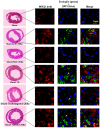MicroRNA-208a increases myocardial fibrosis via endoglin in volume overloading heart
- PMID: 24392114
- PMCID: PMC3879305
- DOI: 10.1371/journal.pone.0084188
MicroRNA-208a increases myocardial fibrosis via endoglin in volume overloading heart
Abstract
MicroRNA-208a (mir-208a) is essential for cardiac hypertrophy and fibrosis. Endoglin, a co-receptor of transforming growth factor-β is also essential for cardiac fibrosis. Endoglin has been shown to be a target of mir-208a in the in vitro mechanical stress model. Volume overload can lead to heart failure and cardiac fibrosis. The role of mir-208a and endoglin in volume overload heart failure is well known. We sought to investigate the mechanism of regulation of mir-208a and endoglin in volume overload-induced heart failure. Aorta-caval (AV) shunt was performed in adult Sprague-Dawley rats to induce volume overload. Heart weight and heart weight/body weight ratio significantly increased in AV shunt animals. AV shunt significantly increased left ventricular end-diastolic dimension as compared to sham group. Mir-208a was significantly induced by AV shunt from 3 to 14 days. Endoglin, myosin heavy chain-β and brain natriuretic peptide were significantly induced by AV shunt from 3 to 14 days. Overexpression of mir-208a in the sham group without AV shunt significantly increased endoglin expression similar to the AV shunt group. Antagomir-208a attenuated the endoglin expression induced by AV shunt. Pretreatment with atorvastatin also attenuated the endoglin expression induced by AV shunt. AV shunt significantly increased myocardial fibrosis as compared to sham group. Overexpression of mir-208a in the sham group significantly increased myocardial fibrosis. Antagomir-208a and atorvastatin significantly attenuated the myocardial fibrosis induced by AV shunt. In conclusion, mir-208a increased endoglin expression to induce myocardial fibrosis in volume overloaded heart failure. Treatment with atorvastatin can attenuate the myocardial fibrosis induced by volume overload through inhibition of endoglin expression.
Conflict of interest statement
Figures






Similar articles
-
MicroRNA-208a Increases Myocardial Endoglin Expression and Myocardial Fibrosis in Acute Myocardial Infarction.Can J Cardiol. 2015 May;31(5):679-90. doi: 10.1016/j.cjca.2014.12.026. Epub 2014 Dec 29. Can J Cardiol. 2015. PMID: 25936493
-
Cyclic stretching boosts microRNA-499 to regulate Bcl-2 via microRNA-208a in atrial fibroblasts.J Cell Mol Med. 2021 Mar;25(6):3113-3123. doi: 10.1111/jcmm.16373. Epub 2021 Feb 18. J Cell Mol Med. 2021. PMID: 33605072 Free PMC article.
-
Overexpression of miR-142-3p improves mitochondrial function in cardiac hypertrophy.Biomed Pharmacother. 2018 Dec;108:1347-1356. doi: 10.1016/j.biopha.2018.09.146. Epub 2018 Oct 4. Biomed Pharmacother. 2018. PMID: 30372837
-
miR-208a in Cardiac Hypertrophy and Remodeling.Front Cardiovasc Med. 2021 Dec 9;8:773314. doi: 10.3389/fcvm.2021.773314. eCollection 2021. Front Cardiovasc Med. 2021. PMID: 34957257 Free PMC article. Review.
-
The emerging role of miR-208a in the heart.DNA Cell Biol. 2013 Jan;32(1):8-12. doi: 10.1089/dna.2012.1787. Epub 2012 Nov 2. DNA Cell Biol. 2013. PMID: 23121236 Review.
Cited by
-
Tumor Necrosis Factor-Alpha and the ERK Pathway Drive Chemerin Expression in Response to Hypoxia in Cultured Human Coronary Artery Endothelial Cells.PLoS One. 2016 Oct 28;11(10):e0165613. doi: 10.1371/journal.pone.0165613. eCollection 2016. PLoS One. 2016. PMID: 27792771 Free PMC article.
-
Circulating MicroRNAs and myocardial involvement severity in chronic Chagas cardiomyopathy.Front Cell Infect Microbiol. 2022 Aug 8;12:922189. doi: 10.3389/fcimb.2022.922189. eCollection 2022. Front Cell Infect Microbiol. 2022. PMID: 36004323 Free PMC article.
-
The miR-214-3p/c-Ski axis modulates endothelial-mesenchymal transition in human coronary artery endothelial cells in vitro and in mice model in vivo.Hum Cell. 2022 Mar;35(2):486-497. doi: 10.1007/s13577-021-00653-6. Epub 2022 Jan 3. Hum Cell. 2022. PMID: 34978047
-
Differential microRNA Expression and Regulation in the Rat Model of Post-Infarction Heart Failure.PLoS One. 2016 Aug 9;11(8):e0160920. doi: 10.1371/journal.pone.0160920. eCollection 2016. PLoS One. 2016. PMID: 27504893 Free PMC article.
-
Current Knowledge of MicroRNAs (miRNAs) in Acute Coronary Syndrome (ACS): ST-Elevation Myocardial Infarction (STEMI).Life (Basel). 2021 Oct 8;11(10):1057. doi: 10.3390/life11101057. Life (Basel). 2021. PMID: 34685428 Free PMC article. Review.
References
-
- Sutton MGSJ, Sharpe N (2000) Left ventricular remodeling after myocardial infarction. Pathophysiology and therapy. Circulation 101: 2981–2988. - PubMed
-
- Fonsatti E, Altomonte M, Arslan P, Maio M (2003) Endoglin (CD105): a target for anti-angiogenic cancer therapy. Curr Drug Targets 4: 291–296. - PubMed
-
- Chen K, Mehta JL, Li D, Joseph L, Joseph J (2004) Transforming growth factor-β receptor endoglin is expressed in cardiac fibroblasts and modulates profibrogenic actions of angiotensin II. Circ Res 95: 1167–1173. - PubMed
-
- Rodríguez-Barbero A, Obreo J, Alvarez-Munoz P, Pandiella A, Bernabéu C, et al. (2006) Endoglin modulation of TGF-β1-induced collagen synthesis is dependent on ERK1/2 MAPK activation. Cell Physiol Biochem 18: 135–142. - PubMed
-
- Bartel DP (2004) MicroRNAs: genomics, biogenesis, mechanism, and function. Cell 116: 281–297. - PubMed
Publication types
MeSH terms
Substances
LinkOut - more resources
Full Text Sources
Other Literature Sources

